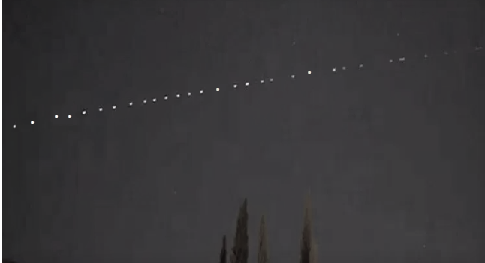Starlink Disruption, A Course of Action
I hope this post finds you well.

When I first heard of the Starlink internet satellite company started by Elon Musk, I was thrilled, now everyone all over the world can get internet access, especially in remote areas. Then, I heard they are putting up 12,000 satellites, all in low earth orbit. I was like 12,000! … the sky will be in motion. Then I read Starlink put in a request for another 30,000. This will be a total of 42,000. Note: There are other companies getting into this business also.
I think people in the city will not care, they can’t see the stars anyway. The most effected will be the amateur/professional astronomers, star gazers and the people who like to view the aurora borealis and the Milky way. … I say this is definitely a disruptor.
What we need is some kind of disruptor compensation legislation for congress to pass. Legislation that will help those affected by these fast-accelerating technologies, that disrupt existing businesses and, in this case, astronomers and star gazers. Small bookstores were decimated by Amazon and the internet. There was no help given to them. Even when congress decided to allow internet purchases to be exempt from taxes. The poor bookstores, they never had a chance. I don’t believe that congress will pass any disruptor compensation legislation now, they can’t agree on anything.
So, let’s do this:
I propose an alternative. I say we go to Elon Musk (Starlink) and any other company seeking to enter the satellite internet service to install an additional fee on the subscribers, say $1, call it a disruptor compensation fee. It should not interfere with the Starlink company business. But it should be enough to compensate the effected. The money should be used to launch space telescopes, for professionals, amateurs and citizens scientist. The money from the fee would go to a not-for-profit entity that will build, manage, arrange and contract out for a constellation of small space telescopes. Say 1,000 of them. Since there are going to be 42,000 Starlink internet satellites, what’s a few more.
Maybe we could use the Starlink system as a way to communicate to the space telescope satellites. The money can also be used to develop web-based apps to communicate and operate the space telescope. Some of the uses for these space telescopes would be for near earth asteroid hunting. Lots of people would use it to search for the elusive planet 9. I think the planet 9 hunters would love the opportunity to predict the orbit and position and actually have a chance to look for it. Also, astronomy clubs, teacher assisted classrooms, citizen scientist and others would love to check out some time with an orbiting space telescope. Continuous observation of the moon would be nice. Say 8K or the latest resolution image chips. Just think, 1,000 of these space telescopes would give a lot of people opportunities to explore the skies. No weather permitting observations ever again. Just think, 24/7 access to observe.
At Reviews.org an article indicated that Starlink is going to charge approx. $80 per month, for the satellite internet service. Plus, about $100–$300 fee for the terminal. A Forbes.com article I read said Starlink projected that they were going to have up to 14 million subscribers by 2025. If the disruptor compensation fee were $1/mo, then that money could certainly pay for many small space telescopes for both the amateur and professional astronomers. Maybe limit the size of the telescopes, so as to fit 5 space telescopes per launch. Even this money could be used to pay SpaceX for delivering to orbit. It could be a win – win for SpaceX.
The idea here is to just deal with the disruptor with a compensation fee (with Elon Musk’s permission) and put small space telescopes out in space. The number of these could be in the thousands. Amateurs, citizen scientist and professional could look, weather and atmosphere free, at just about anything. Reliable launches, plenty of satellite companies that can build the components and plenty of astronomers, I think this could be a desired goal to achieve.
Final Thoughts:
This is just an alternative idea to deal with this disruptor. Just put the telescopes and sensors above the satellite internet constellation. And give access to all, provided the users take some kind of course and get certified.
I am a wannabe astronomer who uses his binoculars once or twice a year to view the moon. I would love the chance to be a citizen scientist and reserve time for a space telescope to view the rings of Saturn or even look for planet 9. I’m sure lots of the young students would also. Please give us a chance to explore. The more telescopes (eyes), the more we will discover.
I hope this work around for the Starlink disruptor idea helps.
Sources:
Reviews.org ‘SpaceX Starlink Satellite Internet Update 2020’ https://www.reviews.org/internet-service/spacex-starlink-satellite-internet-review/
Forbes.com ‘How Much Value Can SpaceX Unlock from Starlink’s Proposed IPO?’ https://www.forbes.com/sites/greatspeculations/2020/02/13/how-much-value-can-spacex-unlock-from-starlinks-proposed-ipo/#5627e1106a7c